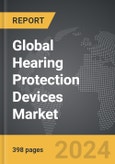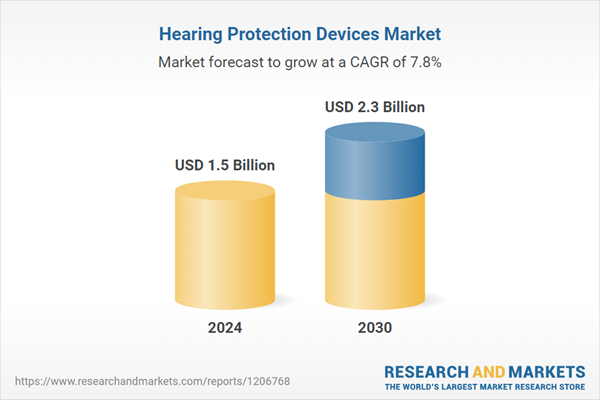The global market for Hearing Protection Devices was estimated at US$1.5 Billion in 2024 and is projected to reach US$2.3 Billion by 2030, growing at a CAGR of 7.8% from 2024 to 2030. This comprehensive report provides an in-depth analysis of market trends, drivers, and forecasts, helping you make informed business decisions. The report includes the most recent global tariff developments and how they impact the Hearing Protection Devices market.
Technological advancements have significantly enhanced the performance and usability of hearing protection devices. Modern HPDs incorporate features such as adjustable fit, enhanced comfort, and improved noise attenuation capabilities. Innovations in materials science have led to the development of hypoallergenic and more durable materials, ensuring long-term use without discomfort or skin irritation. Advanced electronic HPDs now offer adaptive noise reduction, which automatically adjusts the level of noise attenuation based on the surrounding environment, providing optimal protection while allowing for situational awareness. Some devices also include Bluetooth connectivity, enabling users to communicate and listen to audio without compromising their hearing protection. These technological improvements have broadened the application range of HPDs, making them suitable for a variety of settings from industrial workplaces to leisure activities.
The growth in the hearing protection devices market is driven by several factors, including legislations which enforce standards of worker safety, employment rates, increasing awareness regarding safety among industrial workforce, rising sense of professionalism that accelerates acceptance of protective wear as part of worker's paraphernalia, growing dynamism in the retail and services sector, and rise in career prospects for risky professions. The increasing awareness of the long-term health impacts of noise-induced hearing loss is a major driver, prompting more stringent occupational safety regulations and standards. Technological advancements in materials and noise-canceling technologies are making HPDs more effective and comfortable, encouraging their adoption across diverse industries. Additionally, the rise in construction and manufacturing activities, particularly in developing regions, is boosting the demand for effective hearing protection solutions. The growing popularity of recreational activities that involve high noise levels, such as shooting sports and live concerts, is further expanding the market. The emphasis on workplace safety and the implementation of comprehensive hearing conservation programs by employers are also contributing to market growth. Together, these factors are fostering a dynamic and expanding market for hearing protection devices, presenting significant opportunities for innovation and development in the field of occupational health and safety.
Global Hearing Protection Devices Market - Key Trends & Drivers Summarized
Hearing protection devices (HPDs) are essential safety equipment designed to protect individuals from the harmful effects of excessive noise exposure. These devices come in various forms, including earplugs, earmuffs, and electronic noise-canceling devices, each tailored to specific environments and noise levels. Earplugs, typically made from foam or silicone, fit snugly into the ear canal to block out sound, making them ideal for environments with continuous noise exposure, such as manufacturing plants and construction sites. Earmuffs, which cover the entire ear, provide a higher level of protection and are often used in conjunction with earplugs in extremely loud environments. Electronic noise-canceling devices, equipped with advanced technology to actively reduce ambient noise, are increasingly popular in both industrial and recreational settings, such as shooting ranges and motorsport events.Technological advancements have significantly enhanced the performance and usability of hearing protection devices. Modern HPDs incorporate features such as adjustable fit, enhanced comfort, and improved noise attenuation capabilities. Innovations in materials science have led to the development of hypoallergenic and more durable materials, ensuring long-term use without discomfort or skin irritation. Advanced electronic HPDs now offer adaptive noise reduction, which automatically adjusts the level of noise attenuation based on the surrounding environment, providing optimal protection while allowing for situational awareness. Some devices also include Bluetooth connectivity, enabling users to communicate and listen to audio without compromising their hearing protection. These technological improvements have broadened the application range of HPDs, making them suitable for a variety of settings from industrial workplaces to leisure activities.
The growth in the hearing protection devices market is driven by several factors, including legislations which enforce standards of worker safety, employment rates, increasing awareness regarding safety among industrial workforce, rising sense of professionalism that accelerates acceptance of protective wear as part of worker's paraphernalia, growing dynamism in the retail and services sector, and rise in career prospects for risky professions. The increasing awareness of the long-term health impacts of noise-induced hearing loss is a major driver, prompting more stringent occupational safety regulations and standards. Technological advancements in materials and noise-canceling technologies are making HPDs more effective and comfortable, encouraging their adoption across diverse industries. Additionally, the rise in construction and manufacturing activities, particularly in developing regions, is boosting the demand for effective hearing protection solutions. The growing popularity of recreational activities that involve high noise levels, such as shooting sports and live concerts, is further expanding the market. The emphasis on workplace safety and the implementation of comprehensive hearing conservation programs by employers are also contributing to market growth. Together, these factors are fostering a dynamic and expanding market for hearing protection devices, presenting significant opportunities for innovation and development in the field of occupational health and safety.
Scope of Study:
The report analyzes the Hearing Protection Devices market in terms of units by the following Segments, and Geographic Regions/Countries:- Segments: Product Type (Earplugs, Earmuffs, Hearing Bands, Uniform Attenuation Earplugs); End-Use (Mining, Construction, Manufacturing Sites, Military, Forestry, Healthcare, Other End-Uses)
- Geographic Regions/Countries: World; USA; Canada; Japan; China; Europe; France; Germany; Italy; UK; Spain; Russia; Rest of Europe; Asia-Pacific; Australia; India; South Korea; Rest of Asia-Pacific; Latin America; Argentina; Brazil; Mexico; Rest of Latin America; Middle East; Iran; Israel; Saudi Arabia; UAE; Rest of Middle East; Africa.
Key Insights:
- Market Growth: Understand the significant growth trajectory of the Earplugs segment, which is expected to reach US$1.6 Billion by 2030 with a CAGR of a 7.9%. The Earmuffs segment is also set to grow at 8.3% CAGR over the analysis period.
- Regional Analysis: Gain insights into the U.S. market, estimated at $502.6 Million in 2024, and China, forecasted to grow at an impressive 11.1% CAGR to reach $398.6 Million by 2030. Discover growth trends in other key regions, including Japan, Canada, Germany, and the Asia-Pacific.
Why You Should Buy This Report:
- Detailed Market Analysis: Access a thorough analysis of the Global Hearing Protection Devices Market, covering all major geographic regions and market segments.
- Competitive Insights: Get an overview of the competitive landscape, including the market presence of major players across different geographies.
- Future Trends and Drivers: Understand the key trends and drivers shaping the future of the Global Hearing Protection Devices Market.
- Actionable Insights: Benefit from actionable insights that can help you identify new revenue opportunities and make strategic business decisions.
Key Questions Answered:
- How is the Global Hearing Protection Devices Market expected to evolve by 2030?
- What are the main drivers and restraints affecting the market?
- Which market segments will grow the most over the forecast period?
- How will market shares for different regions and segments change by 2030?
- Who are the leading players in the market, and what are their prospects?
Report Features:
- Comprehensive Market Data: Independent analysis of annual sales and market forecasts in US$ Million from 2024 to 2030.
- In-Depth Regional Analysis: Detailed insights into key markets, including the U.S., China, Japan, Canada, Europe, Asia-Pacific, Latin America, Middle East, and Africa.
- Company Profiles: Coverage of players such as Honeywell International, Inc., Accolade Safety Pte. Limited, Delta Plus Group, Alpine Hearing Protection, Gateway Safety, Inc. and more.
- Complimentary Updates: Receive free report updates for one year to keep you informed of the latest market developments.
Some of the 91 companies featured in this Hearing Protection Devices market report include:
- Honeywell International, Inc.
- Accolade Safety Pte. Limited
- Delta Plus Group
- Alpine Hearing Protection
- Gateway Safety, Inc.
- Hellberg Safety AB
- Amplifon SpA
- David Clark Co., Inc.
- Hultafors Group AB
- E D Bullard Company
- EAR, Inc.
- INVISIO Communications AS
- Audinc Custom Ear Plugs
- Guangzhou J&Y Safety Products Manufacturer Co., Ltd.
- Ear Deals Pty Limited
This edition integrates the latest global trade and economic shifts as of June 2025 into comprehensive market analysis. Key updates include:
- Tariff and Trade Impact: Insights into global tariff negotiations across 180+ countries, with analysis of supply chain turbulence, sourcing disruptions, and geographic realignment. Special focus on 2025 as a pivotal year for trade tensions, including updated perspectives on the Trump-era tariffs.
- Adjusted Forecasts and Analytics: Revised global and regional market forecasts through 2030, incorporating tariff effects, economic uncertainty, and structural changes in globalization. Includes segmentation by product, technology, type, material, distribution channel, application, and end-use, with historical analysis since 2015.
- Strategic Market Dynamics: Evaluation of revised market prospects, regional outlooks, and key economic indicators such as population and urbanization trends.
- Innovation & Technology Trends: Latest developments in product and process innovation, emerging technologies, and key industry drivers shaping the competitive landscape.
- Competitive Intelligence: Updated global market share estimates for 2025, competitive positioning of major players (Strong/Active/Niche/Trivial), and refined focus on leading global brands and core players.
- Expert Insight & Commentary: Strategic analysis from economists, trade experts, and domain specialists to contextualize market shifts and identify emerging opportunities.
- Complimentary Update: Buyers receive a free July 2025 update with finalized tariff impacts, new trade agreement effects, revised projections, and expanded country-level coverage.
Table of Contents
I. METHODOLOGYII. EXECUTIVE SUMMARY2. FOCUS ON SELECT PLAYERSIV. COMPETITION
1. MARKET OVERVIEW
3. MARKET TRENDS & DRIVERS
4. GLOBAL MARKET PERSPECTIVE
III. MARKET ANALYSIS
Companies Mentioned (Partial List)
A selection of companies mentioned in this report includes, but is not limited to:
- Honeywell International, Inc.
- Accolade Safety Pte. Limited
- Delta Plus Group
- Alpine Hearing Protection
- Gateway Safety, Inc.
- Hellberg Safety AB
- Amplifon SpA
- David Clark Co., Inc.
- Hultafors Group AB
- E D Bullard Company
- EAR, Inc.
- INVISIO Communications AS
- Audinc Custom Ear Plugs
- Guangzhou J&Y Safety Products Manufacturer Co., Ltd.
- Ear Deals Pty Limited
Table Information
| Report Attribute | Details |
|---|---|
| No. of Pages | 398 |
| Published | July 2025 |
| Forecast Period | 2024 - 2030 |
| Estimated Market Value ( USD | $ 1.5 Billion |
| Forecasted Market Value ( USD | $ 2.3 Billion |
| Compound Annual Growth Rate | 7.8% |
| Regions Covered | Global |









